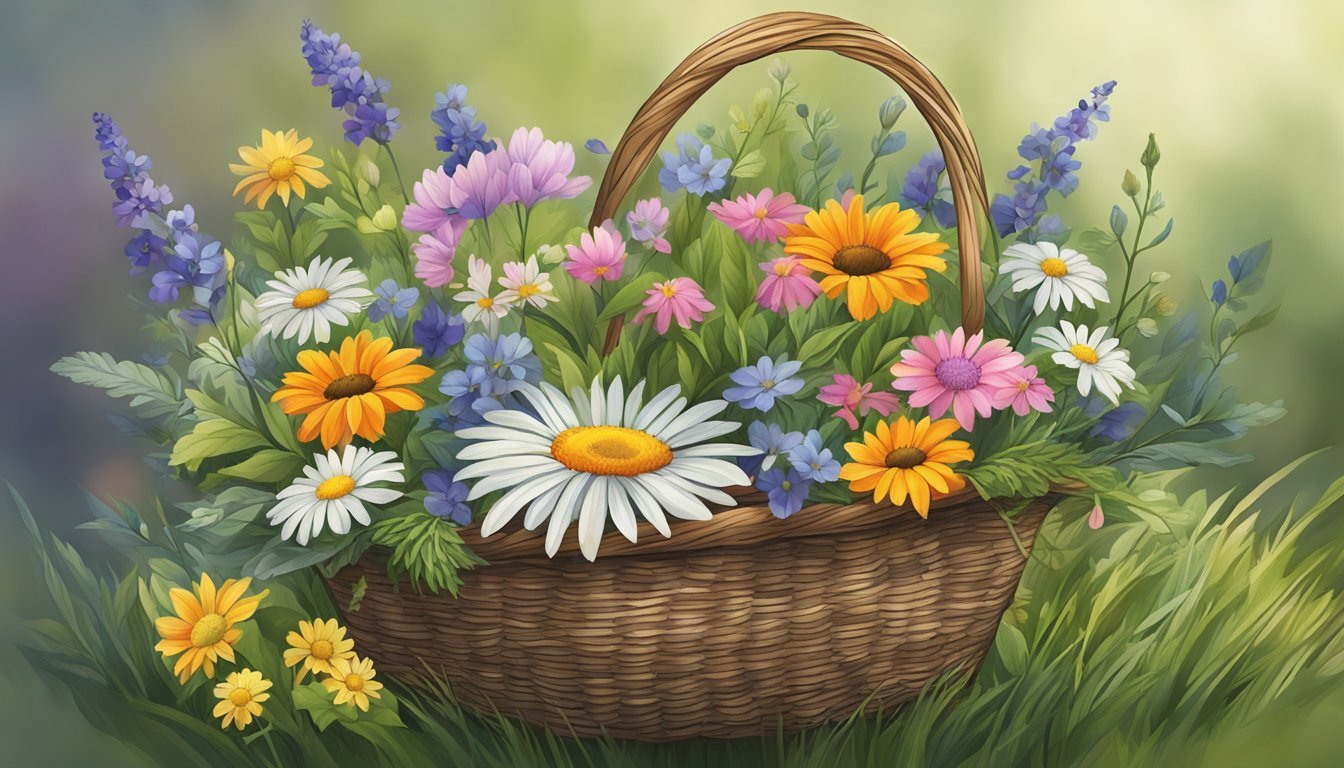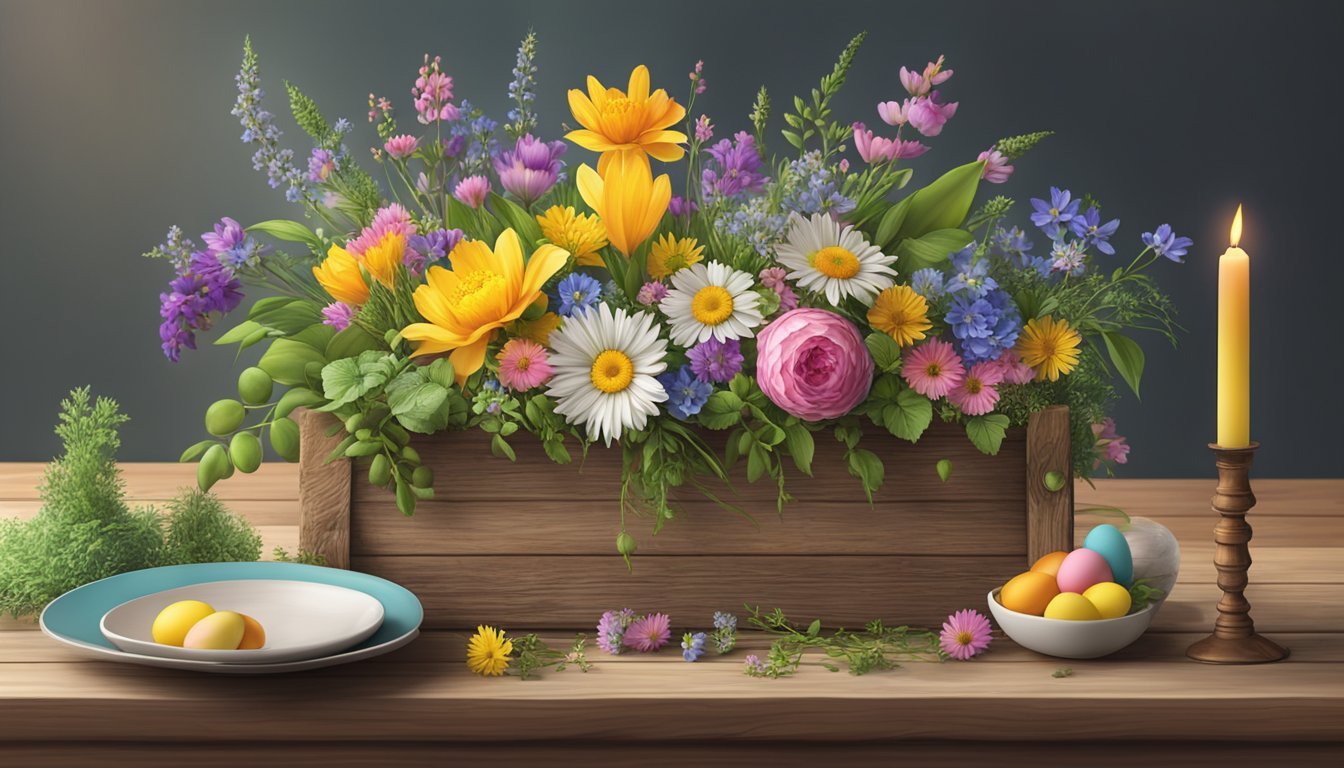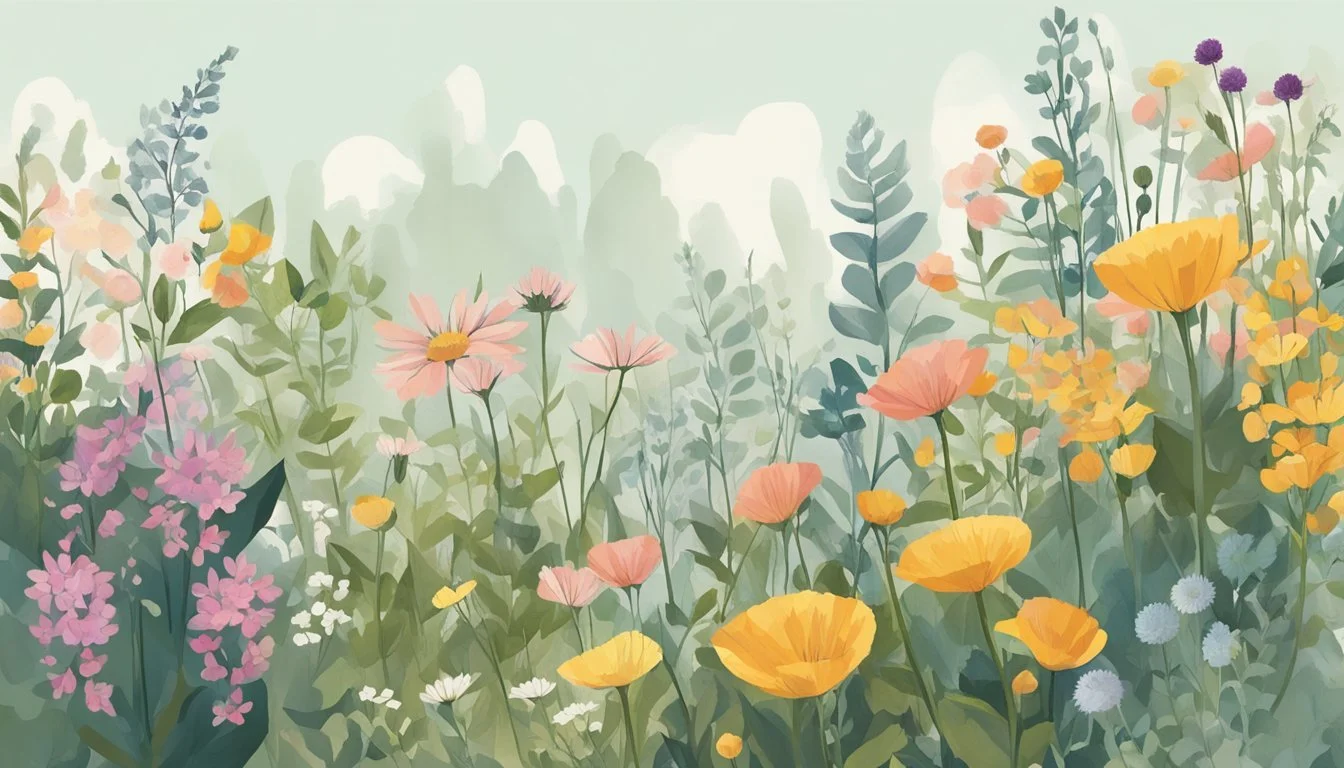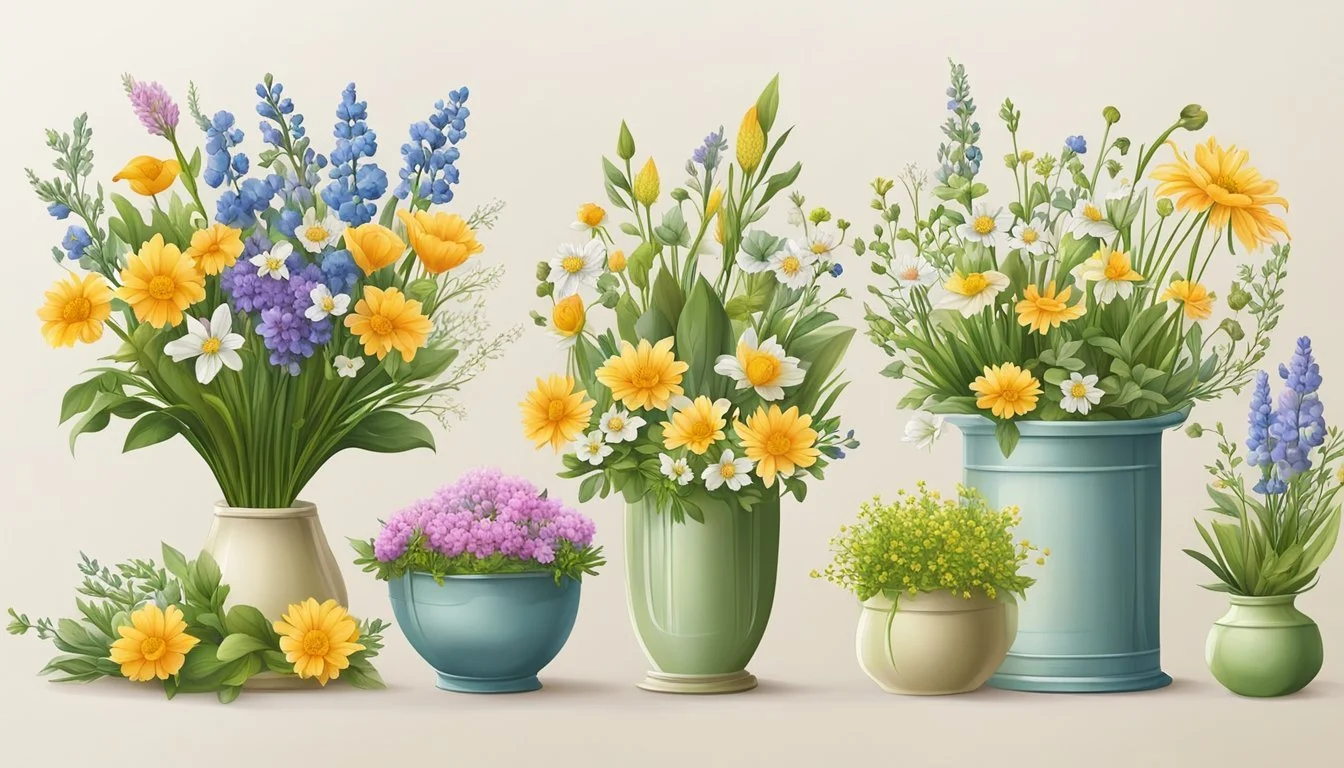Easter Floral Arrangements
Embrace Nature with Wildflowers and Lush Greenery
Easter is a celebration of renewal and the vibrancy of spring, and what better way to reflect these themes than through floral arrangements that harness the beauty of wildflowers and greenery? Embracing the season's offerings, these arrangements often incorporate a mix of blossoming wildflowers and lush foliage, which can transform any space into a charming homage to new beginnings. They offer a natural and warm aesthetic that complements the freshness of spring and the festive spirit of Easter.
Creating an Easter floral display using wildflowers and greenery not only provides a visual feast but also connects indoor spaces with the natural rebirth occurring outdoors. The choice of wildflowers, such as daffodils and tulips, along with the assorted greenery, can add texture and depth to any arrangement. These elements are frequently paired to create contrasts in color and form, creating arrangements that capture the essence of spring’s diversity and Easter’s promise of renewal.
Wildflowers specifically suit Easter floral arrangements due to their informal beauty, which represents the spontaneous and lively nature of spring. The season's palette—with its soft pinks, vivid yellows, and crisp whites—is often mirrored in these natural compositions. Arrangements that feature wildflowers and greenery are not just visually appealing but also evoke the simplicity and peace associated with this time of year. They serve as a subtle yet powerful reminder of the season's enduring theme of rebirth and rejuvenation.
The Charm of Easter Wildflowers
Easter wildflowers bring a unique and natural beauty to springtime celebrations. By selecting the right blossoms and understanding their symbolism, one can create arrangements that are both visually pleasing and rich in Easter tradition.
Selecting the Best Spring Wildflowers
When choosing wildflowers for Easter arrangements, one should seek out species that are in season to create an authentic springtime display. Here is a list of spring wildflowers commonly used for Easter:
Bloodroot: A delicate white flower symbolizing purity and new beginnings.
Trillium: Known for its three-petaled white flowers, signifies elegance and beauty.
Violets: These purple blooms are often associated with humility and faithfulness.
Tulips: A wide range of color options, representing deep love and happiness.
For a harmonious arrangement, one should combine different textures and heights. It's important to remember that wildflowers have a more relaxed form, so the arrangements should reflect that effortless natural grace.
Understanding Wildflower Symbolism for Easter
Easter, a time of renewal and rebirth, finds its perfect floral match in wildflowers. They possess a layered meaning that enhances the celebration:
Lilies: Traditionally associated with Easter, symbolize purity and hope.
Daffodils: Signify rebirth and are often one of the first flowers to bloom in spring.
Forget-me-nots: Represent lasting love and remembrance, adding depth to any arrangement.
When creating an Easter floral display, incorporating these wildflowers with their rich symbolism adds not just charm but also a deeper connection to the roots of the holiday. Their natural, unstructured appearance reminds one of the renewal taking place in nature during spring.
Creating the Perfect Easter Floral Arrangement
The key to a perfect Easter floral arrangement lies in understanding the fundamentals of design, selecting an appropriate container, and mastering arrangement techniques.
Fundamentals of Arrangement Design
To create a visually appealing Easter floral arrangement, one must consider balance, color, and texture. Balance is achieved by considering the height and volume of flowers, ensuring that the arrangement doesn't lean or appear lopsided. For color, Easter arrangements often feature soft pastels and vibrant spring hues that reflect the season's palette. Incorporating a variety of textures through the use of different flowers and greenery can add depth and interest to the design.
Choosing the Right Container
The container for an Easter flower arrangement should complement the style and color scheme of the design. Options range from traditional vases to more unconventional choices like baskets or even hollowed-out eggshells for mini arrangements. The container's size should be proportional to the space where the arrangement will be displayed and capable of holding the floral design securely.
Arrange with Style: Techniques and Tips
When arranging flowers, start with a base of greenery to create the framework of the arrangement. Next, add the focal flowers — these are often the largest or most colorful blooms. Fill in gaps with smaller flowers and accent pieces. Remember to vary the heights and textures for a dynamic appearance. A valuable technique is to place the tallest elements in the center or at the back, gradually working down to smaller elements at the borders.
Use floral foam or a grid of tape across the container's opening to hold stems in place.
Rotate the arrangement while working to ensure balance from all angles.
Place delicate flowers where they won't be crushed.
The creation of a perfect Easter floral arrangement requires a thoughtful approach to design, container selection, and floristry techniques. With these elements in mind, one can craft a beautiful and seasonally appropriate display.
Incorporating Greenery and Foliage
When crafting Easter floral arrangements, the inclusion of greenery and foliage serves as a foundation that complements and enhances the vibrancy of wildflowers. It brings texture, fullness, and color variation, setting the stage for a lively Easter display.
The Role of Greenery in Easter Arrangements
Greenery acts as the backbone of any floral arrangement, especially during Easter. It offers a natural look that signifies renewal and growth—themes synonymous with the season. Incorporating various types of greenery can add texture and depth to arrangements, creating a fuller and more polished look. Branches and grasses can provide height and structure, while different shades of greens add visual interest.
Key Types of Greenery: Eucalyptus, ferns, ivy, and myrtle.
Textures Offered: Smooth eucalyptus leaves, feathery ferns, and soft, trailing ivy.
Structure Examples: Firm branches and flexible grasses, providing varying heights.
Selecting Complementary Greens for Your Flowers
The art of selecting greenery lies with considering the shapes, sizes, and textures that will best complement the main flowers. For wildflowers, which often have a delicate and informal appearance, one should look for greens that echo this casual beauty without overpowering the arrangement.
Eucalyptus: Its silvery-green leaves bring a soft hue that pairs well with pastel wildflowers.
Grasses: Wispy grasses gently support airy wildflowers, adding a sense of movement.
Sizing: Choose smaller greens to allow the wildflowers to remain the focal point.
Using a variety of greenery in terms of texture, size, and shape can elevate an Easter arrangement from pleasant to captivating, all the while holding true to the elegance of spring's natural bounty.
Color and Texture: Bringing Life to Arrangements
The use of color and texture is vital in creating captivating Easter floral arrangements. They employ a vibrant palette and a variety of materials to add depth and interest.
Color Palettes for Easter: Brights and Pastels
Easter arrangements often feature a harmonious blend of bright and pastel hues, reflecting the freshness and renewal of the season. Bright colors like yellow and pink bring energy, while pastels such as lavender and soft green evoke a sense of tranquility.
Bright Colors: Yellow (daffodils, tulips), Pink (cherry blossoms, roses)
Pastels: Lavender (lilacs), Soft Green (baby ferns, ivy)
Textural Contrast: A Feast for the Eyes
Texture in floral arrangements introduces visual drama and emphasizes the natural beauty of the blooms. Combining elements such as the softness of petals and the roughness of bark or the smoothness of leaves can greatly enhance the arrangement.
Soft Textures: Petals of blooms, fuzzy lamb's ear
Rough Textures: Bark, twigs, and dried elements
Special Easter Touches
Incorporating thematic elements like Easter eggs and natural materials can transform a simple wildflower and greenery arrangement into an Easter centerpiece. These seasonal touches not only add color and texture but also infuse your arrangement with the festive spirit of the holiday.
Adding Easter Eggs and Candy Elements
For a playful nod to Easter traditions, Easter eggs can be nestled among the flowers and foliage. One could use pastel-colored plastic eggs or hand-painted wooden ones for a more authentic feel. To sweeten the display, adding small wrapped candy pieces, such as chocolate eggs or jelly beans, can offer a delightful treat for guests.
Easter Eggs: Pastel, metallic, or patterned eggs can act as focal points.
Candy: Strategically place wrapped treats for a burst of color and whimsy.
Thematic Natural Additions: Moss and Branches
Incorporating elements like moss and branches into your arrangement captures the essence of a woodland Easter scene. Moss can be used as a base to give the impression of a lush forest floor, supporting the other elements with a verdant, textured bed. Adding branches, such as willow or birch, can create vertical interest and mimic the natural growth patterns of a wild garden.
Moss: A soft bed for a natural, earthy look.
Branches: Curved or straight, they add height and structure.
Focal Flowers and Complementary Blooms
Creating an Easter floral arrangement involves selecting focal flowers that will capture attention and complementing them with blooms and grasses that create harmony. The choice of flowers and their arrangement tells a story through color, texture, and seasonal relevance.
Highlighting Seasonal Flowers: Tulips and Daffodils
Tulips are quintessential spring blooms that stand out as focal flowers in Easter arrangements due to their bright colors and bold shapes. They come in various hues such as deep purples, vibrant yellows, and passionate reds. Daffodils, with their trumpet-shaped blossoms and sunshine color palette, naturally complement tulips by elevating the arrangement's freshness and vibrancy.
Seasonal Focal Flowers:
Tulips: Deep purples, vibrant yellows, passionate reds
Daffodils: Bright yellows, whites, and oranges
These spring flowers inherently evoke the essence of renewal and growth that the season symbolizes. When positioned as the stars of an arrangement, they create a captivating focal point.
Filler Flowers and Grasses: Crafting Harmony
Filler flowers, including species like ranunculus and spray roses, play a supportive role by adding fullness and completing the aesthetic of the arrangement. Their smaller blooms fill in gaps and provide a color bridge between the focal flowers and the greenery. Adding grasses or slender foliage introduces an element of natural wildness, enhancing the texture and creating a seamless transition between the more structured flowers and the organic feel of the arrangement.
Examples of Harmony Elements:
Filler Flowers: Spray roses, ranunculus
Grasses: Elegantly arching grasses, soft textural grass varieties
The interplay between the bold tulips, cheerful daffodils, delicate filler flowers, and flowing grasses results in a balanced and harmonious display fit for any Easter celebration.
Height, Size, and Scale in Arrangements
The creation of Easter floral arrangements revolves around the crucial aspects of height, size, and scale, ensuring that the display is visually pleasing and appropriate for the setting.
Balancing Proportions for Tablescapes
In tablescapes, the balance of height, size, and scale is paramount. Mason jars and small baskets work well for low arrangements, ensuring guests can converse easily across the table. For larger tables, one might consider using a series of smaller vases to create a sense of abundance without overwhelming the space.
Height: Should not obstruct views across the table; typically no taller than 12 inches.
Size: Proportional to the table; larger tables can handle more volume.
Scale: Smaller vases or containers ensure individual elements are not lost.
Arrangements for Different Spaces in the Home
Different spaces within the home require attention to the specific scale of arrangements. The size of the arrangement should be in harmony with the room’s dimensions and the furniture within it.
Entryways: Tall and vertical arrangements can create a dramatic first impression.
Living Areas: Medium-sized arrangements on coffee or side tables add a focal point without dominating the space.
Dining Room: A centerpiece that is low and wide allows for easy conversation.
Utilizing wildflowers and greenery in varying heights aids in producing a natural and dynamic look. The selection of a vase or other containers should match the feel of the wildflowers, like using a simple glass jar to reflect a more rustic charm.
Seasonal Containers and Vases
When creating Easter floral arrangements, the selection of containers and vases plays a pivotal role. They not only hold the flowers but also contribute to the overall aesthetic, complementing the natural beauty of wildflowers and greenery.
Mason Jars and Bud Vases: Casual Chic
Mason Jars provide a versatile option for Easter arrangements. They can be dressed up with ribbons or twine to match any decor, offering a casual yet chic look. Bud Vases, on the other hand, are perfect for showcasing individual stems, allowing the wildflowers' intricate details to stand out. Aligning several bud vases together forms an understated centerpiece that celebrates the simplicity of spring.
Ideal Wildflowers for Mason Jars and Bud Vases:
Wild daisies
Bluebells
Buttercups
Greenery to Pair:
Ferns
Baby's breath
Eucalyptus
Egg Baskets and Papier-Mâché Vases: Easter Delights
For a themed approach, Egg Baskets can be repurposed as vases that echo the spirit of the holiday. Lining the basket with moss or a discreet insert can secure the arrangement. Papier-Mâché Vases introduce a DIY element and can be created in various Easter shapes, such as eggs or rabbits, adding a fun and festive touch to the setting.
Creating Papier-Mâché Vases:
Inflate a balloon as a mold for an egg-shaped vase.
Apply layers of papier-mâché, let dry, and paint in pastel colors.
Using Enamelware Colanders:
For a rustic centerpiece, an Enamelware Colander can function as a unique floral container.
It allows for excellent water drainage, making it suitable for freshly-picked wildflowers that may retain moisture.
By carefully choosing the appropriate seasonal container or vase, one can elevate their Easter floral arrangements with charm and character, reflecting the joy and renewal that the season brings.
Practical Tips for Flower Arranging
Creating beautiful Easter floral arrangements with wildflowers and greenery requires not only creativity but also some practical know-how. This section will outline the essential supplies one needs and how to keep those fresh flowers looking their best throughout the Easter celebration.
Basic Floral Supplies You'll Need
To begin assembling your Easter floral arrangements, one will require a few basic floral supplies. Here is a concise checklist:
Vases or Containers: They come in various shapes and sizes, suitable for the type of flowers and the desired arrangement style.
Floral Foam: For holding stems in place, especially in more intricate designs.
Floral Wire and Floral Tape: Useful for securing and manipulating stems or attaching flowers to arrangements.
Scissors or Secateurs: Sharp tools are essential for cutting stems without damaging them.
Watering Can or Spray Bottle: Key for hydrating arrangements and keeping flowers fresh.
Maintaining Freshness: Floral Care
Once the supplies are gathered, proper care is paramount to ensure the longevity of the arrangement. Below are key care tips for fresh flowers:
Water: Fresh flowers thrive best in clean water. It’s recommended to change the water every two days to prevent bacterial growth.
Sunlight: While some sunlight can keep flowers vibrant, too much direct exposure can cause them to wilt prematurely.
Temperature: Keep arrangements in a cool area to extend their freshness.
Floral Food: If available, use floral food in the water to provide extra nutrients and inhibit bacteria.
Cutting Stems: Cut flower stems at a 45-degree angle before placing in water to allow for maximum water absorption.
Leaf Removal: Remove leaves that will sit below the waterline to reduce decay.
Ideas for Easter Floral Decorations
Easter heralds a season of renewal and festivity, reflected in vibrant floral arrangements that become the centrepiece of home decorations. Opting for wildflowers and greenery not only brings a touch of nature indoors but also creates unique and memorable settings for family gatherings.
Easter Table Settings and Centerpieces
A well-designed Easter table can spark conversations and contribute to the festive mood. Wildflower centerpieces are eye-catching, with their unexpected colors and textures offering a fresh take on traditional Easter decor.
Table Runners: Line the center of the table with a mix of greenery like ferns and ivy, interspersed with colorful wildflowers such as bluebells or poppies.
Place Settings: Individual wildflowers can be placed in small clear vases or tied with a ribbon at each place setting for a personalized touch.
Accenting Your Home: Wreaths and Bouquets
When it comes to decorating areas beyond the dining room, wreaths and bouquets infuse the home with the spirit of the season.
Wreaths: Adorn your entrance or a feature wall with a wreath made of intertwined greenery, like eucalyptus or willow, accented with clusters of wildflowers for a welcoming Easter display.
Coffee Table Arrangements: A low-lying bouquet on the coffee table acts as a conversation starter, blending greens and blooms in a relaxed yet sophisticated arrangement.
Incorporating wildflowers and greenery in Easter decorations adds unique character to the festivities, inviting nature’s spontaneity into every nook of the home.
Do-It-Yourself Easter Floral Crafts
Easter floral crafts offer a fantastic way to combine the beauty of springtime flowers with the joy of creating something special. These crafts serve as perfect centerpieces for an Easter brunch or as vibrant decorations to enjoy with family.
Handmade Floral Crafts for the Family
Handmade floral crafts provide an ideal activity for family bonding. Materials like light pink roses, white tulips, and daffodils bring a burst of color to any setting. Begin by selecting a vase. A short, small vase suits petite arrangements, while a larger one accommodates more expansive displays. After choosing a vase, one can create a grid across the opening with tape. This grid will guide stem placement, ensuring that each flower stands out.
Steps for Creating Floral Arrangements:
Prepare: Select a vase and create a grid on top with tape.
Arrange: Place stems of flowers like roses and tulips following the grid.
Fill: Use Queen Anne's lace and greenery to fill gaps and add texture.
Crafting a bird's nest garnish with eggs adds a thematic touch to the floral craft. One can nestle this adornment among the flowers or place it at the top for a charming focal point.
Easter Florals as a Creative Outlet
Easter offers a season brimming with creative potential. Floral crafts enable people to express their creativity and customize arrangements to their liking. For a subtle yet elegant look, muted tones of painted cut-down cups with petal shapes can be integrated alongside real flowers. One can also construct a centerpiece by attaching floral wire to desired pieces, giving structure to the creation.
Creative Floral Craft Ideas:
Petaled Cups: Cut and paint cups to resemble petals, adding an inventive twist.
Floral Foam Designs: Use floral foam within an egg carton, cover lightly with greens, and add flowers like carnations or daisy pompoms to create a structured design.
It is important to seek a balanced arrangement that highlights both the florals and the container. Whether it's using a mix of bright wildflowers or subtle greenery, the final composition should evoke the freshness of spring and the warmth of the Easter holiday.






